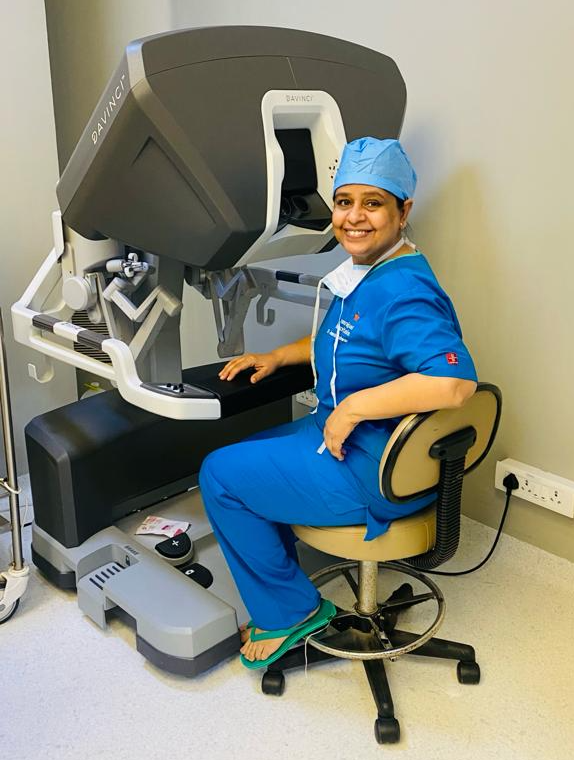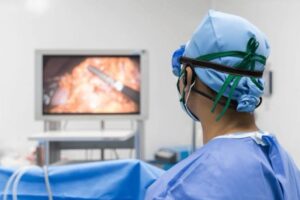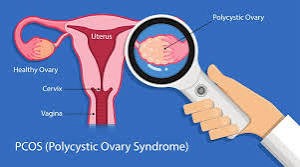Robotic surgery is an advanced form of minimally invasive endoscopic surgery where surgeons use a computer-controlled robot to assist them in certain surgical procedures. Small incisions on the abdomen are made, through which the surgeon passes a camera and instruments to complete a procedure.
The surgeon works from a computer console in the operating room, controlling the surgical robot, which has miniaturized instruments mounted on the robotic arms. This requires approximately four to five 8mm incisions on the abdomen. The surgeon looks through a 3D camera attached to robotic arm, which magnifies the surgical site in great detail and allows for the surgeon to perform precise dissection. As the surgeon moves their hand, the movements are transmitted through the surgical console to the instruments attached to the robot’s arms. Its a team that supervises the robot at the patient’s bedside.
The robotic hands precisely replicate the surgeon’s hand movements while smoothing out hand tremors and scaling movements as needed. The surgical console’s ergonomics also help to ease surgeon fatigue.
The introduction of Robotic Surgery to the field of Gynecology has resulted in large changes in surgical management. The robotic platform allows surgeons to perform more complex procedures.The robot is being increasingly used for gynecologic procedures such as hysterectomies, myomectomies, adnexal surgery,tubal anastomosis, sacrocolpopexy and cancer surgery.
Laparoscopic procedures come with their own set of drawbacks such as 2D vision,less in-depth perception, camera instability, and limited range of motion.
Advantages of Robotic-assisted surgery
1. Fast recovery time
In robotic-assisted surgeries,smaller incisions are given, which means less cutting through skin, fat, muscles, and other tissues. It reduces the recovery time and enables faster home return and back to normal routine.
2. Less surgical risk
Though all surgeries come with some sort of risk, Robotic-assisted gynecological surgery minimizes the risk especially in complex surgery.
3. Better visualization
With high-resolution 3D image magnifies the operating field clearly, giving the surgeon better visualization of the area that needs to be treated during the surgery.thus it has an advantage in complex surgery.
4. Technical advantage
The endowrist movement of the robotic instrument is free from tremors and enables the surgeon to perform complex procedures with enhanced precision, dexterity, and control.
it helps in surgery and suturing at odd locations.
What are the gynecologic conditions treated with robotic surgery and who is a candidate?
Robotic Myomectomy
Leiomyoma is the most common benign gynecologic tumor diagnosed in women during reproductive age. Myomectomy is a safe treatment in symptomatic patients who desire to preserve their fertility. The fertility preserving surgical approach includes abdominal myomectomy (AM), laparoscopic myomectomy (LM), and robotic-assisted myomectomy (RAM). The appropriate surgical treatment should be individualized depending on myoma dimensions, number, localization, and surgeon skills.
Robotic-assisted surgery, a surgeon can easily remove as many myomas of varying sizes. They also help in removing and suturing of myomas in odd locations.
Robotic assisted myomectomy is as effective and safe as conventional laparoscopic myomectomy. Moreover, the value of RAS could offer a minimally invasive approach to patients that otherwise would be treated with open surgery. The limitations are related to the higher costs and longer operating time.
Robotic Endometriosis Treatment
Endometriosis is a chronic inflammatory condition that affects women during reproductive age. Endometriosis is associated with pelvic pain and infertility, but the severity of symptoms is not predictive of the stage of the disease. Endometriosis surgery is one of the most complex laparoscopic surgeries due to the distortion of the normal anatomy, adhesions, and hypomobility of the pelvic organs. Robotic surgery is considered beneficial in severe endometriosis with urinary and bowel involvement.
Currently, both robotic and laparoscopic are acceptable techniques for endometriosis surgical treatment.Robotic offers enhanced visualization and higher dexterity that can overcome some laparoscopic limitations. Furthermore, according to the current evidence, robotic surgery could be the best option in complex cases with deep infiltrating endometriosis.
Robotic Hysterectomy
Hysterectomy is one of the most performed surgical procedures worldwide. In 90% of cases, benign pathologies are the main indication for the surgical procedure.Surgical approaches to benign hysterectomy include laparotomy,laparoscopic , vaginal and robotic techniques.
Over time, both open and vaginal approaches are decreasing in popularity, while the widespread adoption of robotic-assisted hysterectomy gave access to a larger number of patients to minimally invasive techniques, even in cases of severe obesity and complex hysterectomy.
Robotic Pelvic Organ Prolapse Treatment
Pelvic organ prolapse (POP) is a common cause of morbidity in women with a remarkable impact on quality of life. Surgery can offer a wide range of options to restore pelvic anatomy and function. The gold standard surgical treatment for vaginal vault prolapse is sacrocolpopexy. It is a surgery done to correct Pelvic prolapse, a condition that occurs when muscles and ligaments that support the pelvic organs such as the uterus, vagina, cervix, bladder, urethra, or rectum weaken and make these organs slip from their normal position.Robotic sacrocolpopexy patients experienced a minor rate of postoperative complications compared to laparoscopic approach.
Gynecologic cancers
Robotic assisted Radical hysterectomy is done for cancer of the cervix or endometrium in early stages. It has an advantage of early recovery.
What is the typical recovery for robotic surgery?
Recovery after robotic surgery is very similar to recovery after laparoscopic surgery. Most patients can safely go home after their robotic procedure. In general, to be safely discharged home from the recovery area, patients need to demonstrate that their pain is well controlled and that they have urinated after surgery.
Patient can walk by their first night after surgery . Depending on the type of surgery that is performed, most people may return to fully normal activity within two to six weeks.
Is robotic surgery right for me?
Only a surgeon you trust can help you make that decision. Have a conversation with Dr Aneeta Talwar to determine if your condition can be treated by surgery and if so, if a robotic approach is right for you.






